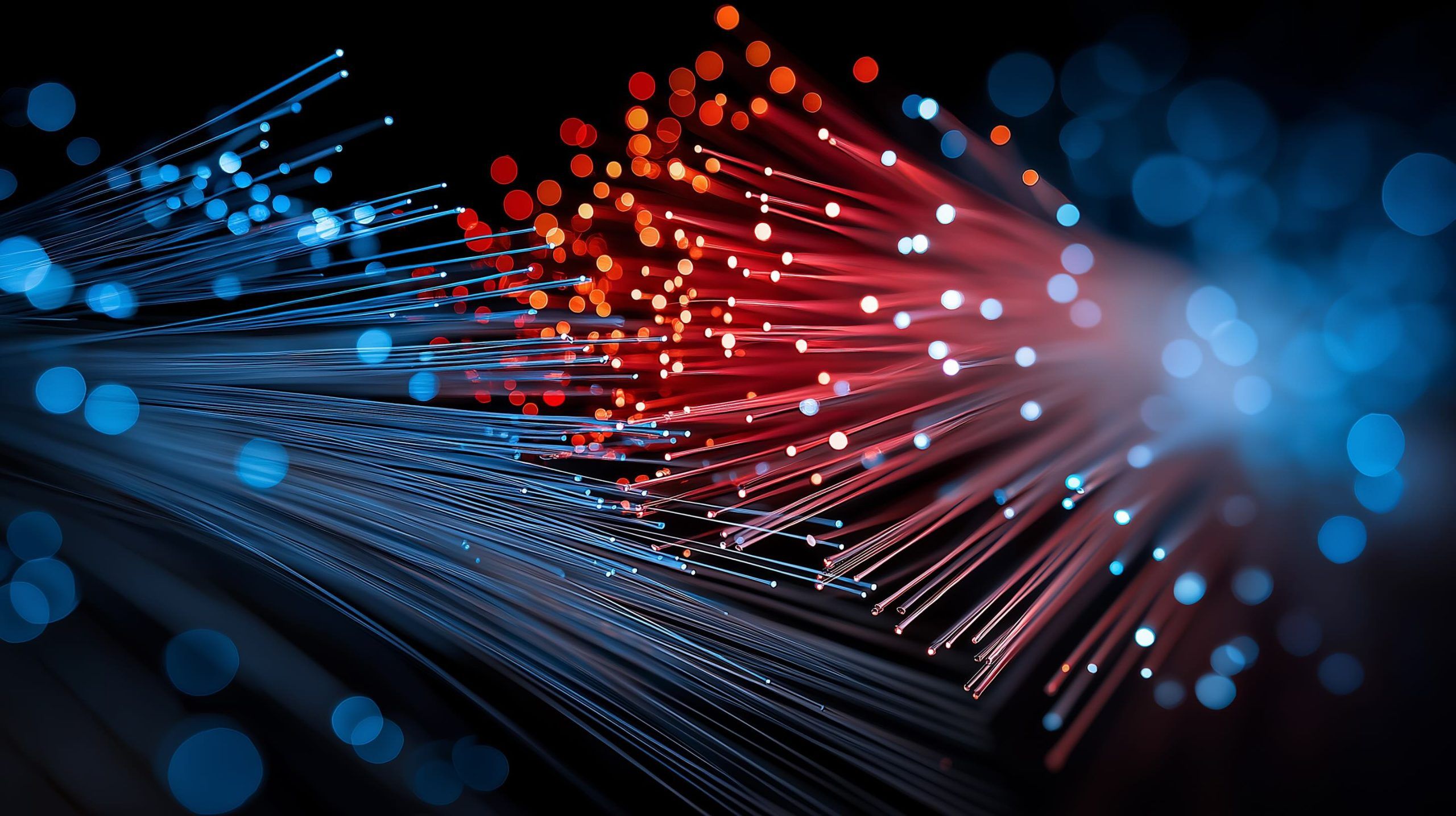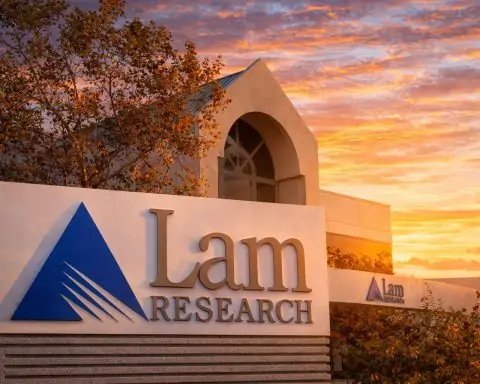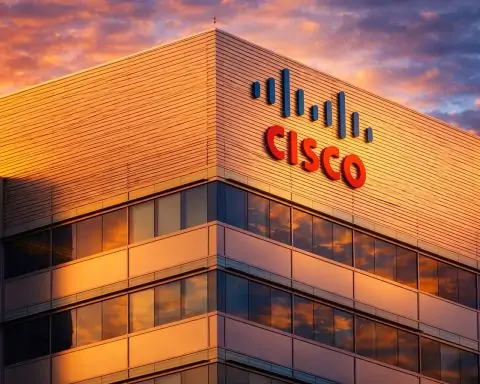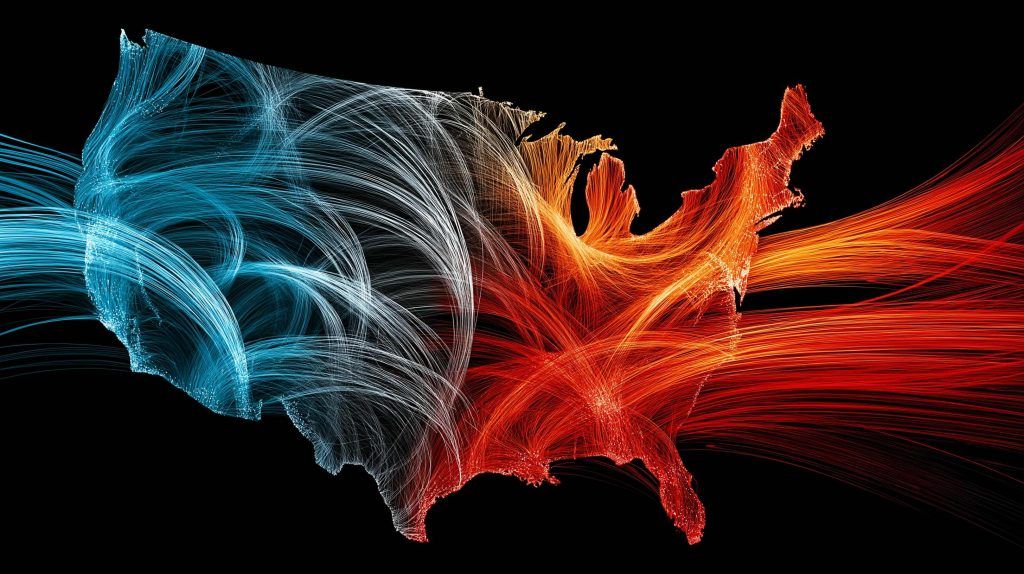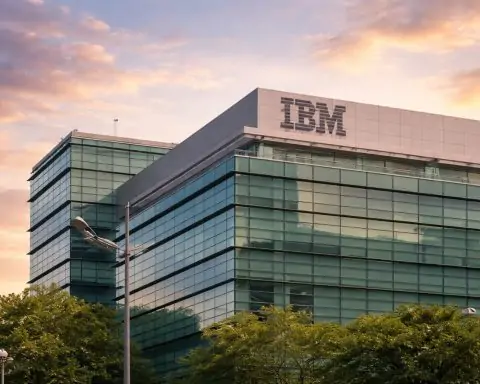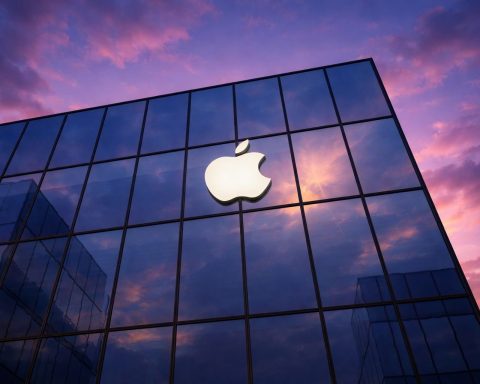- The United States has committed over $42.5 billion through the BEAD program to accelerate fiber deployment to unserved areas.
- South Korea now delivers fiber to about 89% of broadband subscribers, the highest share worldwide.
- India’s BharatNet project has extended fiber internet to over 214,000 villages, bringing Wi‑Fi connectivity to remote areas.
- In China, 95% of internet users could access 100 Mbps+ service in 2023, and by 2027 about 90% of broadband subscribers are projected to be on fiber connections.
- Next-generation standards are enabling 10 Gbps+ services: 10G-PON and XGS-PON, and China is commercially rolling out 50G-PON delivering up to 50 Gpbs.
- IBM announced co-packaged optics in late 2024, moving fiber-optic communication inside data centers at the chip level to speed AI data transfers.
- Cisco highlights AI-driven network operations (AIOps) that enable automated self-healing and significant reductions in outages.
- The global telecom AI chatbot market grew from $302 million in 2024 to $428 million in 2025.
- In mid-2024 Lumen Technologies secured a contract to connect Microsoft AI data centers with high-bandwidth fiber, and by the end of 2024 had over $8 billion in new fiber connectivity contracts.
- The European Union’s Digital Decade targets universal gigabit connectivity by 2030, with Germany aiming for 50% fiber coverage by 2025 and 100% by 2030.
A Global Broadband Transformation is Underway
The world’s internet infrastructure is undergoing a revolutionary upgrade in 2025. Fiber-optic networks are rapidly expanding across both developed and emerging markets, delivering multi-gigabit speeds and unprecedented reliability. At the same time, artificial intelligence (AI) is being infused into network operations, making internet services smarter and more efficient. Together, these technologies are turbocharging internet access – boosting speeds, reducing downtime, and extending connectivity to more people than ever before. Governments and private ISPs are investing heavily to bridge the digital divide, bringing high-speed broadband to rural communities and underserved regions [1] [2]. In parallel, AI-powered tools are optimizing traffic and automating maintenance behind the scenes, quietly improving our everyday online experience.
Fiber broadband is spreading at a record pace. In the United States, massive funding programs (like the $42.5 billion BEAD initiative) are accelerating fiber buildouts to unserved areas, recognizing broadband as essential infrastructure [3] [4]. Across the European Union, ambitious “gigabit society” targets aim for near-universal high-speed coverage this decade [5]. Asia leads the world in fiber adoption: South Korea now delivers fiber to ~89% of broadband subscribers – the highest rate globally – closely followed by Japan and parts of Europe [6]. Even in developing regions, fiber deployments are gathering momentum. For example, India’s BharatNet project has extended fiber internet to over 214,000 villages, bringing Wi-Fi connectivity to remote areas [7] [8]. Meanwhile, China has essentially leapt to an all-fiber future: as of 2023, 95% of Chinese internet users could access 100 Mbps+ service, and by 2027 an estimated 90% of all broadband subscribers in China will be on fiber connections [9]. This global push for fiber is laying the groundwork for a faster, more reliable internet everywhere.
Artificial intelligence is emerging as the secret sauce behind these improvements. Telecom operators are deploying AI systems that monitor network health, predict problems, and fine-tune performance in real time. “AI is only as powerful as the network that supports it,” notes Gary Bolton, CEO of the Fiber Broadband Association, “Fiber is the only broadband technology capable of delivering the speed, scalability, and reliability AI requires.” [10] Fiber’s huge capacity and low latency make it the backbone of the AI revolution in connectivity [11] [12]. In turn, AI helps maximize fiber’s potential – from optimizing data flows to managing complex network infrastructure with minimal human intervention. The result is an internet service that not only runs faster, but smarter.
AI and Fiber: A Powerful Combination for Speed and Reliability
Fiber-optic technology is fundamentally superior to legacy copper and cable systems, transmitting data via light at extreme speeds. Modern fiber networks easily offer gigabit and multi-gigabit internet plans to consumers, with symmetric upload/download rates that empower cloud computing, 4K streaming, and remote work with equal ease [13]. “The beauty of fiber is it’s symmetrical,” says John Stankey, CEO of AT&T, touting fiber’s ability to send as much data upstream as downstream – a critical advantage as interactive and cloud applications proliferate [14]. This symmetry and sheer capacity provide a future-proof foundation for digital innovation. In fact, 2025 is widely regarded as the year optical fiber will shine again, thanks to next-gen standards like 10G-PON and XGS-PON that enable 10 Gbps+ services to homes [15] [16]. In China, telecom providers are even rolling out 50G-PON technology capable of 50 Gbps speeds, putting the country ahead of the world in ultra-broadband deployment [17]. These advancements ensure that fiber networks can handle the exploding data demands of AI applications and high-definition content for years to come.
Artificial intelligence complements fiber by revolutionizing how networks are managed. ISPs are increasingly using AI-driven software to make their operations proactive rather than reactive. For example, predictive maintenance systems analyze sensor and performance data to anticipate equipment failures or fiber line damage before they cause outages [18] [19]. This means technicians can fix weak spots in the network preemptively, dramatically reducing unplanned downtime. Traffic optimization is another AI use-case: machine learning algorithms crunch real-time traffic patterns and automatically reroute data to prevent congestion, ensuring consistently high speeds even at peak hours [20]. AI-powered network operations (AIOps) can detect anomalies (like a sudden spike in latency or packet loss) and trigger self-healing protocols within seconds [21] [22]. According to Cisco, this automated, real-time anomaly detection and self-healing significantly reduces outages and improves service reliability [23] [24]. In short, AI enables smarter networks that dynamically adapt to maintain optimal performance. Instead of manually tuning networks device by device, operators now rely on AI to continuously monitor and optimize thousands of nodes – from local fiber exchanges to core routers – far more efficiently than humans ever could.
Crucially, AI is also enhancing customer-facing aspects of internet service. Many ISPs have deployed AI chatbots and virtual assistants to improve customer support and responsiveness. These bots can instantly handle routine queries (resetting a password, diagnosing Wi-Fi issues) and are available 24/7, reducing wait times for subscribers. Telecom operators report that AI tools are boosting first-contact resolution rates and cutting support costs. In fact, one analysis cites Gartner’s projection that by 2025, roughly 85% of customer interactions in telecom will be managed by AI systems, vastly reducing the need for human intervention in common support tasks [25] [26]. Customers increasingly appreciate the immediacy of AI-driven support, whether through chat or voice assistants, especially for simple requests. And for complex issues that still require human experts, AI assists by triaging problems and providing technicians with diagnostic insights. The net effect is a smoother, faster customer service experience. Generative AI in particular saw rapid adoption in telecom over the past year – the global market for AI chatbots in telecom grew from about $302 million in 2024 to $428 million in 2025 [27] – as providers raced to leverage new AI models to personalize offers and handle surging support loads. In short, AI is helping ISPs not only run their networks better, but also deliver a more seamless customer experience, from smarter routing of internet traffic to smarter handling of customer requests.
Recent Innovations and Industry Moves in 2024–2025
The past year has seen a flurry of breakthroughs and major announcements at the intersection of AI and fiber. What seemed like futuristic talk only a couple of years ago is now materializing in real-world deployments. Here are some of the most notable developments driving the ISP revolution in 2025:
- Explosion of Fiber Demand from AI Applications: Telecom carriers report an unprecedented surge in bandwidth needs thanks to the AI boom. “AI happens to be blowing up our industry,” says Debra Freitas, CEO of Light Source Communications, “It’s in response to the amount of data that AI is demanding.” [28] In the U.S., Lumen Technologies secured a landmark contract in mid-2024 to provide high-bandwidth fiber connectivity between Microsoft’s growing AI data centers [29]. According to Lumen’s CMO Ryan Asdourian, demand for fiber is rising at an “incredible rate,” and high-capacity routes have become “the scarce resource right now” as cloud giants race to interlink their AI infrastructure [30]. Lumen’s CTO Dave Ward went so far as to call the current expansion “the largest expansion of the internet in our lifetime,” underscoring how AI workloads are driving operators to lay more fiber than ever before [31]. By the end of 2024, Lumen had won over $8 billion in new fiber connectivity contracts to support AI and cloud companies, with more on the way [32]. This trend is echoed globally – telecom vendors like Nokia report that traditional telco spending is now being outpaced by orders from data center and AI clients. Nokia’s CEO Pekka Lundmark noted in late 2024 that telecom is no longer the top growth market for the company; instead, AI data centers have become the prime focus after Nokia won a multi-country optical equipment deal with AI startup CoreWeave [33]. Likewise, Ciena’s CEO Gary Smith observed that “our business is linked heavily into the growth of bandwidth around the world,” as AI-related demand brings in new projects from both service providers and hyperscalers [34]. In short, AI’s insatiable hunger for data is reshaping the telecom landscape, forging new partnerships between fiber carriers and tech giants and fueling record investments in network capacity.
- Fiber Network Expansion and Mergers: Traditional ISPs are doubling down on fiber to fend off competition and prepare for the future. AT&T – one of the largest U.S. ISPs – is aggressively swapping old copper lines for fiber-optic cable to boost speeds and cut maintenance costs. “We’re going full court press on fiber,” AT&T executives declared in mid-2025 as the company accelerated its fiber rollout [35]. AT&T even agreed to acquire fiber assets from Lumen to expand its footprint into cities like Denver and Las Vegas [36]. The strategic rationale is clear: fiber can handle the coming “boom from a new generation of data-heavy AI tools” in a way outdated DSL and cable cannot [37]. Swapping copper for fiber also yields operational benefits – 70% lower energy usage and 35% lower maintenance costs – while enabling future multi-gig services and symmetrical bandwidth that modern cloud applications demand [38]. Other providers are following suit. In Europe, incumbents and new players alike are investing in fiber to meet EU connectivity goals. Spain and France have already achieved fiber coverage above 80% of households [39] [40], and France aims for 98% fiber coverage by 2025 through a blend of private deployments in cities and publicly funded projects in rural areas [41]. Germany, after lagging for years, launched a Gigabit Strategy to cover at least half of all homes with fiber by end of 2025 [42]. By mid-2024 Germany had only reached ~36.8% of households, but fiber buildouts were ramping up by 33% year-over-year and analysts believe the 50% target is within reach [43] [44]. Even the UK – no longer in the EU but pursuing its own national fiber plans – is seeing a fiber frenzy: BT Openreach and altnet providers like CityFibre collectively pass millions of new premises each year, aiming to approach nationwide coverage late this decade. Mergers and partnerships have also marked this revolution; operators are teaming up with tech firms and each other to extend fiber’s reach. For instance, Google Fiber resumed expansions in several U.S. cities and launched multi-gig tiers (up to 5 Gbps and 8 Gbps) to showcase fiber’s capabilities [45]. Clearly, around the globe, ISPs view fiber optics as the future-proof platform for delivering internet, and they are racing to deploy it widely – through organic growth, acquisitions, and public-private initiatives – to gain a competitive edge in the new AI-powered era.
- Network Automation and Digital “Self-Healing”: Hand in hand with new fiber pipes, carriers are deploying advanced network automation platforms often branded as AIOps (AI Operations). In February 2025, Cisco highlighted how AI-driven network ops allow service providers to manage “massive, complex networks” with far less downtime [46]. Real-world trials showed that AI can automate network configuration changes, continuously optimize routing, and even execute automated failovers when a fiber link is at risk [47] [48]. These self-correcting networks rely on streams of telemetry data – precisely the kind of big data that fiber networks can carry in real time – to keep internet traffic flowing smoothly. A major focus is on predictive failure analysis: AI algorithms learn the normal patterns of network devices and fiber optic performance, and can detect subtle anomalies (a slightly weakening optical signal, an unusual traffic spike) that precede a failure [49]. The system can then alert engineers or take direct action, such as rerouting traffic or rebooting equipment, to prevent any customer-impacting outage. Thanks to these innovations, some ISPs report significantly improved uptime and faster restoration times when issues do occur. Industry experts predict that over the next five years, spending on such AI/ML network tools will grow substantially as operators seek to “facilitate convergence and service reliability” across their broadband and mobile networks [50]. In essence, telecom networks are evolving into intelligent platforms that can monitor, heal, and optimize themselves – an invaluable capability as networks grow ever more complex with the expansion of fiber deep into neighborhoods and the overlay of 5G small cells and IoT devices.
- Optical Innovations for the AI Age: The convergence of AI and fiber has also spurred breakthroughs in hardware. At the tail end of 2024, IBM announced a new “co-packaged optics” technology that brings fiber-optic communication inside data centers at the chip level [51]. By tightly integrating optical links with silicon chips, IBM’s prototype dramatically increases the speed at which servers can talk to each other – a critical factor for training AI models that must shuffle enormous datasets between GPUs. This could eventually allow data center networks to run at light speed, eliminating bottlenecks for AI workloads [52]. In simpler terms, fiber isn’t just connecting data centers anymore; it’s moving onto the server racks and motherboards to accelerate computing. Similarly, the rise of edge computing and smart homes has led to concepts like Fiber-to-the-Room (FTTR), being pioneered in China [53]. FTTR extends fiber cables to individual rooms in a home or office (rather than just to a single modem), ensuring ultra-fast and low-latency connectivity for high-bandwidth applications like VR/AR and real-time cloud gaming in every corner of a building [54]. These innovations highlight how fiber infrastructure is adapting to meet new needs driven by AI and immersive media. The broader telecom supply chain is also evolving – for example, equipment vendors are introducing AI-powered optimization software in optical transport gear to squeeze more capacity out of existing fiber strands via smarter signal processing [55]. All told, 2025 is a banner year for telecom tech, with AI both driving demand for better networks and providing the tools to manage those networks more intelligently.
Regional Highlights: How Different Regions are Embracing AI and Fiber
United States: Multi-Gig Speeds and a Rural Connectivity Push
In the U.S., the internet service landscape is being reshaped by fiber deployment and AI adoption on a massive scale. Major ISPs like AT&T, Verizon, Comcast Xfinity, and others are competing to offer multi-gigabit fiber service in more areas, while the government makes an historic investment to connect rural America. AT&T, for instance, has expanded what it calls the nation’s largest fiber network to tens of millions of locations and is steadily converting legacy DSL customers onto fiber lines [56]. The company’s CEO famously highlighted fiber’s symmetrical speed as a key to handling new traffic demands (from videoconferencing to AI cloud apps) [57]. Fiber-to-the-home buildouts have also accelerated thanks to the federal Broadband Equity, Access, and Deployment (BEAD) program, which is injecting funds to bring fiber and high-speed access to underserved counties [58]. States are partnering with ISPs to lay fiber trunk lines to remote towns that were previously broadband deserts. Additionally, public-private partnerships (PPPs) are playing a growing role: local governments and providers are teaming up to share costs and expertise in deploying fiber to low-density communities that might not be profitable otherwise [59]. This collaborative approach is helping close the rural connectivity gap, ensuring that small towns and farming regions aren’t left behind in the gigabit era.
On the technology front, American ISPs are early adopters of AI to improve network quality. Cable operators and fiber ISPs alike use AI-based traffic management to tackle peak-hour congestion – for example, identifying localized slowdowns (say, a neighborhood node overloaded with video streams) and rerouting capacity or dynamically balancing loads. Customer service bots are also widespread; virtually every major ISP now offers an AI chat agent on its support website or mobile app. These bots can schedule technician visits, guide users through troubleshooting steps, or even upsell them to a better plan based on usage patterns. Analysts note that U.S. telecom firms have embraced AI not only to cut support costs but to enhance customer retention by providing more proactive care. For instance, some broadband providers use AI to predict which customers might be experiencing poor Wi-Fi coverage or service issues (by analyzing device signals and network logs) and then reach out with solutions before the customer calls in. Telecom executives are vocal about AI’s potential: “Service providers can no longer afford to be one-dimensional; they must become more customer-centric and meet customers wherever they are,” advises Zayo Group president Andres Irlando on the need for AI-driven personalization [60]. Meanwhile, U.S. network engineers are increasingly trusting AI systems to handle routine maintenance – Verizon and AT&T have both reported using machine learning to predict fiber cuts or generator failures so they can dispatch crews preemptively. With gigabit fiber spreading and AI helping run the show, U.S. broadband users are starting to enjoy the benefits: more reliable connections and the dawn of an era of 2–5 Gbps home internet packages that were unheard of a few years ago. The challenge ahead is ensuring these advancements reach all Americans, not just those in dense metro markets.
Europe: Gigabit Goals and Smarter Networks Across the Continent
Europe’s broadband transformation is characterized by ambitious targets and wide adoption of fiber, supported in many cases by national strategies. The European Union’s Digital Decade program has set an overarching goal: universal gigabit connectivity by 2030 for member countries [61]. Many EU nations have interim milestones around 2025. France, via its “Très Haut Débit” plan, targeted full broadband coverage (30 Mbps+) by 2022 and is now pushing toward near-ubiquitous fiber (98% FTTH) by 2025 [62]. As noted, France has already reached over 84% of households with fiber as of late 2023 [63] – one of the highest coverage rates in the West – thanks to a mix of private telco investments in cities and public initiative networks for rural zones. Spain and the Nordic countries likewise boast fiber penetration well above 70%, and even traditionally lagging countries like Italy and the UK have dramatically accelerated fiber rollout in recent years [64] [65]. Germany, Europe’s largest economy, is working to overcome its late start in fiber deployment. The government’s multi-billion-euro gigabit initiative aims to have half of German homes on fiber by 2025 and 100% by 2030 [66]. Despite bureaucratic hurdles, Germany’s fiber connections have been growing ~33% annually and industry watchers expect the 50% by 2025 goal to be achieved or surpassed [67] [68]. Notably, European operators often employ open-access models, where a wholesale fiber network is built (sometimes with state aid) and then various ISPs can offer service over it. This model, seen in countries like Sweden and the Netherlands, increases competition and utilization of each fiber network and has been credited with helping Europe reach high coverage efficiently.
On the AI side, European telecom companies leverage AI especially for network efficiency and cybersecurity. For example, Spain’s Telefónica and Britain’s BT have both discussed AI-driven platforms that optimize routing and bandwidth allocation across their backbone networks. Predictive maintenance has big appeal in Europe as well, where aging infrastructure (like old underground cables in cities) can be a liability – AI systems that flag likely failure points help avoid service disruptions. European regulators have encouraged such innovations, as more reliable broadband is seen as key to economic resilience. Customer service chatbots are also common among European ISPs, often multilingual to serve diverse populations. Vodafone in Germany, Orange in France, and others have AI assistants that handle a significant portion of customer inquiries online, from billing questions to technical support. One unique aspect in Europe is the focus on AI for energy efficiency in networks, aligning with the continent’s green initiatives. Operators use AI to manage power consumption of network equipment (like dynamically dimming lasers on fiber lines during low-traffic hours or optimizing cooling in data centers), which not only cuts costs but also reduces carbon footprint. In terms of notable projects, 2024 saw pan-European collaborations on AI-enabled 5G and fiber integration – for instance, trials of autonomous cars in EU smart cities where fiber backhaul and AI traffic management ensured the ultra-low latency needed for vehicle-to-infrastructure communications. The European telecom community, often through groups like the ETSI and national research programs, continues to explore how AI can support emerging use cases on fiber networks, from remote surgery to industrial IoT. Overall, Europe is leveraging policy, competition, and technology in tandem: pushing fiber deeper into communities while adopting AI to run these networks more cleverly and securely.
Asia: Pioneering Next-Gen Fiber and Network Automation
Asia-Pacific is leading the world in both fiber deployment and innovative uses of AI in telecom. In East Asia, fiber-optic connectivity is nearly ubiquitous. As mentioned, South Korea has almost 89% of all broadband subscribers on fiber connections – the highest share globally – and offers some of the fastest average internet speeds in the world [69]. Japan isn’t far behind, with around 80% fiber penetration and nationwide availability of multi-gigabit services. These countries have been early adopters of new fiber technologies: Japanese ISPs have experimented with 10 Gbps consumer plans for years, and Korean providers are deploying 10G-PON and beyond to support things like 8K streaming and cloud VR. China, with its immense scale, stands out for the sheer magnitude of its network. By the end of 2024, China had over half a billion fiber broadband subscribers, effectively making fiber the default broadband medium for its population [70]. Chinese operators (e.g. China Telecom and China Unicom) have aggressively upgraded urban areas to fiber and even connected many rural villages under government programs. Now China is moving into new frontiers: it’s the first market to roll out 50G-PON technology commercially, aiming to leapfrog to ultra-high speeds of 50 Gbps in coming years [71]. The country is also pursuing Fiber-to-the-Room for premium users, wiring entire buildings at the room level with optical fiber [72]. Beyond terrestrial networks, Asia is innovating in space and wireless to complement fiber – for instance, Japan and India have launched broadband satellites, and China is developing a 13,000-satellite LEO constellation (Guowang) to ensure connectivity even in the hardest-to-reach areas [73]. However, even these wireless systems rely on fiber backhaul on the ground to carry data to the internet, underscoring fiber’s central role.
On the AI front, Asian telecom operators are among the most advanced in adopting AI for network management and services. A number of Japanese and Korean providers use AI-powered congestion control that can guarantee low latency for critical applications (like online gaming or stock trading) by dynamically adjusting network paths. Predictive maintenance is widely practiced – for example, NTT in Japan has developed AI models to predict cable degradation from environmental factors (like heavy rains or earthquakes) and schedule maintenance accordingly [74]. In India, Jio and Airtel – fierce rivals in both mobile and fiber broadband – are leveraging AI to handle the scale of their operations. Jio’s network, which grew to tens of millions of fiber-to-home users in just a few years, uses AI algorithms to monitor each local fiber node and automatically balance traffic or switch routes if one path becomes overloaded. This has allowed Jio to offer relatively low-cost gigabit plans while keeping performance stable, a key to its strategy in India’s price-sensitive market. AI is also transforming customer engagement in Asia. China’s big three telecom companies have rolled out AI-driven customer service across popular apps like WeChat, enabling users to troubleshoot connectivity issues via chat or even augmented reality guides. In Southeast Asia, telcos are using AI to reach underserved customers – for instance, analyzing mobile data usage patterns with machine learning to identify communities that would benefit from a fiber connection or a micro-pop (small local antenna site), and then guiding investment there. Another area is fraud detection and security: given the large mobile payments and digital services ecosystem in Asia, telecom providers employ AI to detect SIM swap fraud, spam calls, and network intrusions in real time [75] [76], bolstering trust in their networks. Asia’s telecom industry is thus a hotbed of AI innovation, often in collaboration with local tech startups and academia. It’s not uncommon to see partnerships where, say, a Korean operator works with an AI lab on optimizing 5G handoffs using machine learning, or a Singaporean ISP incubates a startup’s AI solution for home Wi-Fi optimization. This dynamism means Asia will likely continue to define what truly smart broadband networks look like.
Developing Countries: Bridging Gaps with Fiber, Wireless, and AI
In developing regions of Africa, Latin America, and South Asia, the transformation of internet access is about leapfrogging old technologies and innovating to overcome infrastructure gaps. Many of these countries historically had low fixed-line penetration, but they are now directly embracing fiber optics and advanced wireless as the foundation for connectivity, often supported by global tech firms and international development efforts. A striking example is how Africa is being linked by new undersea fiber-optic cables: Google and Meta have invested in huge subsea cable projects (e.g. Google’s Equiano and “Umoja” cables) to dramatically increase Africa’s bandwidth and reduce internet costs [77] [78]. One cable will even connect Africa directly to Australia via the Indian Ocean, opening a new data route for the continent [79]. These initiatives are expected to boost Africa’s international internet capacity sixfold by 2027, potentially lowering prices and spurring up to $32 billion in economic growth over five years [80]. Terrestrial fiber backbones are also expanding: countries like Kenya, Rwanda, and South Africa have built national fiber grids and cross-border links, sometimes with Chinese financing or public-private models. As a result, some urban centers in Africa now enjoy fiber-to-the-home service and 4G/5G mobile networks fed by fiber backhaul, whereas a decade ago such capacity was unheard of. In Latin America, Mexico provides a case study in progress: the government’s “Internet para Todos” program combined fiber, wireless, and satellite solutions to extend access. By the end of 2023, rural internet coverage in Mexico had increased by 60% compared to 2018, and about 65% of all fixed broadband connections in Mexico were over fiber – a dramatic shift as operators replace copper lines with fiber across the country [81] [82]. Other emerging economies like Brazil and Indonesia are also rolling out fiber in cities and even rural towns, often supported by regional ISPs or community networks that tap into submarine cable landing stations on the coasts.
However, significant challenges remain in closing the digital divide in developing regions. Cost is a major barrier – both the cost of deploying infrastructure in sparsely populated areas and the retail cost of internet to consumers. Sub-Saharan Africa still has the world’s most expensive internet relative to income, and many people rely on mobile data which can be costly and limited [83] [84]. To tackle this, some governments and NGOs are turning to creative hybrid strategies: deploying fiber to town centers and then using Wi-Fi or 4G/LTE wireless to reach final users, or setting up community Wi-Fi hotspots fed by a single fiber connection for a village. AI can help here too. For instance, AI is used to optimize satellite bandwidth allocation for rural satellite broadband, making it more affordable and efficient by predicting usage patterns. ISPs in Africa are also exploring AI-driven network planning – using algorithms to decide the most cost-effective routes for fiber trenches or the best locations for wireless towers to maximize coverage with limited resources. Encouragingly, as connectivity improves, we see local innovation flourishing: African startups are leveraging improved internet to build fintech and e-learning platforms, and they in turn often use AI to scale their services (e.g. chatbots for banking or agriculture advisories via SMS). Experts caution that simply laying fiber isn’t a silver bullet for digital equality. Anriette Esterhuysen, a South African internet policy expert, noted that while the new investments by tech giants are welcome and creating more “haves” online, those without access risk becoming even more marginalized in relative terms [85] [86]. Issues like affordability of devices, digital skills, and reliable electricity supply also need attention [87] [88]. Still, the overall trajectory in developing countries is positive: the internet is spreading and getting faster. From Nigeria to Bangladesh, more people are coming online thanks to the combined efforts of fiber projects, 4G/5G expansions, and initiatives like community networks. Each year, the share of the population using the internet rises (Morocco has reached 90% usage, South Africa ~75%, though some others like the Central African Republic remain below 20% [89] [90]). The hope is that by pairing infrastructure upgrades with inclusive policies, developing nations can use this ISP revolution as a springboard to social and economic development, narrowing the gap with the connected world.
Bridging the Digital Divide: Rural Access and Digital Equity
One of the most critical aspects of the internet transformation in 2025 is its potential to close the digital divide – the gap between those with abundant internet access and those without. Both rural communities in wealthy countries and underserved populations in developing countries stand to benefit if new technologies are deployed equitably. There has been significant progress on this front, but also enduring challenges.
In advanced economies like the U.S. and Canada, the urban-rural connectivity gap has long been an issue, with many rural residents stuck on slow DSL or even lacking broadband entirely. The infusion of government funding (such as the U.S. BEAD program and Canada’s Universal Broadband Fund) is changing that equation by subsidizing fiber builds and other high-speed solutions in low-density areas that private ISPs historically ignored. As mentioned, the U.S. is committing over $42 billion to rural broadband, which is enabling projects to lay fiber to farming communities, mountainous regions, and Tribal lands that were previously offline [91]. Early results are promising – numerous rural counties are slated to get gigabit fiber or fixed wireless links over the next 2–3 years through grants awarded in 2024. States like Arkansas and West Virginia have announced record fiber deployments using these funds, often partnering with local telecom co-ops or regional ISPs that know the terrain. Public-private partnerships have proven particularly effective, marrying public funding with private expertise and efficiency [92]. These efforts not only bring streaming and telehealth to remote households, but also help rural economies (for instance, enabling precision agriculture and home-based businesses that rely on reliable internet).
In Europe, countries are also investing in rural connectivity – the EU’s Connecting Europe Facility and national broadband plans (e.g., Germany’s Gigabitförderung program [93]) devote billions to rural fiber, sometimes using novel techniques like fiber laid alongside rail lines or across electric grids to reach villages. Some European regions employ alternative technologies for the last mile, such as fixed wireless or community mesh networks, when fiber to every house isn’t immediately feasible. What’s important is the principle that baseline high-speed service (100 Mbps and upgradable to gigabit) should be available to all citizens, a goal explicitly stated in EU policy [94].
For developing countries, bridging the divide is even more challenging but also potentially game-changing. Many initiatives focus on affordability: the UN Broadband Commission has a target for entry-level broadband to cost <2% of monthly income by 2025 [95]. To meet such targets, African countries are pursuing strategies like increasing market competition (to drive down prices) and supporting community networks that offer low-cost access. Submarine cable upgrades (as discussed) are expected to reduce wholesale bandwidth costs, which could trickle down to consumers [96]. On land, some countries subsidize rural tower power or fiber backhaul to make it viable for ISPs to serve remote areas. AI comes into play by helping identify the most cost-effective way to expand coverage – for example, mapping population clusters via satellite imagery and then simulating different network rollout scenarios. There are already cases where AI-based tools prioritized which villages in a region to connect first to maximize impact. Additionally, tech companies and NGOs have deployed AI-driven education and training platforms to improve digital literacy in underserved areas (because having access is only helpful if people can use it effectively). The digital divide isn’t just about infrastructure; it’s also about skills and usage, as highlighted by researchers. Bridging it requires parallel investments in human capital.
Despite all the efforts, experts warn that a significant divide persists, and in some places may even widen if not carefully managed [97] [98]. Urban areas are quickly moving to multi-gigabit and AI-enhanced networks, while some rural or poor communities are only now getting basic broadband. To ensure digital equity, stakeholders are pushing for policies like subsidized internet for low-income households, device donation programs, and continued innovation in low-cost technologies (like TV white space wireless or community LTE) as complements to fiber. The hopeful vision is that by the end of this decade, the combination of fiber backbones, last-mile solutions, and AI optimization will make internet access nearly universal – and that the quality gap will shrink so that rural users can enjoy similar speeds and services as urban users. The year 2025 marks an inflection point where closing the digital divide is not just an ideal but a tangible work-in-progress around the world. As networks improve, continued vigilance is needed to keep the momentum inclusive.
Future Outlook: AI and Fiber Shaping the Next Decade of Broadband
Looking ahead, the synergy of AI and fiber is poised to drive the next decade of broadband innovation. By 2030, experts envision a world where ultra-fast connectivity is ubiquitous and largely taken for granted – much like electricity – and where AI is deeply embedded at every layer of the network, from core to edge. What might this future look like?
Expect multi-gigabit internet to become the new normal. With fiber deployments continuing at pace, more consumers will upgrade from megabit speeds to gigabit-class connections. ISPs in many countries have roadmaps for 10 Gigabit residential services, and we’ve already seen trial runs of 25G and 50G fiber technologies in places like China [99]. As 8K video, volumetric streaming, and other data-heavy applications emerge, having 10+ Gbps capacity will ensure seamless experiences. Fiber’s virtually unlimited bandwidth potential (laboratory tests have demonstrated petabit per second on a single fiber strand) means it can scale to support whatever new demands arise [100]. We may also see convergence of networks – the lines between fixed broadband (fiber) and mobile broadband (5G/6G) will blur, since fiber will be the backbone carrying 6G traffic to every neighborhood. The home “router” of 2030 could be a hybrid device that takes a fiber feed and a wireless feed, intelligently managed by AI to give the user the best of both worlds (redundancy, mobility, and speed).
AI, for its part, will turn networks into autonomous digital ecosystems. Industry leaders predict that telcos will spend increasing portions of their budgets on AI and machine learning tools to manage and monetize their networks [101]. Routine network operations in 2030 will likely be fully automated: software bots (AI agents) will handle tasks like capacity planning, real-time network reconfiguration, and even field maintenance (perhaps by directing drones or robots to inspect remote fiber lines). Human engineers will focus more on high-level design and strategy while AI systems maintain the day-to-day stability. AIOps platforms will grow more sophisticated, potentially sharing data between carriers globally to learn and improve – imagine an AI that learns from millions of network incidents across the world and uses that knowledge to preempt issues in any one network. AI will also be crucial in cybersecurity for telecom, as threats become more complex; telecom networks in 2030 might use AI to instantaneously recognize and isolate cyberattacks, whether it’s a malware infiltration or a coordinated DDoS assault, thereby protecting critical communication infrastructure in real time [102] [103].
On the consumer side, AI-driven personalization and services will flourish on top of these robust networks. Smart homes connected by fiber will support AI applications that make life easier – from real-time language translation on video calls to virtual reality telepresence that truly feels lifelike. Fiber’s low latency could enable widespread cloud gaming and XR (extended reality) applications without local high-end hardware. Service providers might offer “network slices” or specialized connectivity profiles tuned by AI for different needs: e.g., a ultra-low-latency slice for an AR surgery session, or a high-throughput slice for backing up huge data sets to the cloud, all dynamically managed. Edge computing will likely expand in tandem, with mini data centers at the edge of fiber networks running AI computations closer to users (important for things like autonomous vehicles or smart city sensors). Many ISPs are already exploring new revenue streams here – leveraging their fiber networks to host edge AI services for businesses, effectively becoming part of the cloud infrastructure.
Crucially, the continued focus will be on closing any remaining gaps. By the late 2020s, the hope is that nearly everyone on the planet will have some level of internet access. Reaching the last few percent will involve a mix of solutions – fiber where feasible, next-gen satellites for remote regions, and community networks supported by national programs. AI can help reduce costs in all these areas, making it economically viable to serve the poorest and most isolated populations. As one telecom analyst put it, “network is the new scarce resource” in the AI era [104], and operators that can efficiently expand and manage their networks will thrive. That means embracing both fiber’s capacity and AI’s intelligence.
In summary, the ISP revolution of 2025 – with fiber-optic infrastructure and AI at its core – is setting the stage for a truly connected global society. We are witnessing the foundation being laid for an internet that is faster, smarter, and more inclusive than ever before. The transformations happening now, from remote African villages getting online, to metro networks self-healing with AI, to new multi-gigabit offerings in our cities, all point toward a future where high-quality internet is as pervasive as air. While challenges of equity and implementation remain, the trajectory is clear: fiber broadband and AI technologies are together driving a new era of connectivity, one that will unlock innovations and opportunities across every industry and community. The revolution is well underway – and it’s a thrilling time to watch how the world comes online at blazing speed, with AI as the intelligent traffic cop keeping the whole system running smoothly. The next chapters of this story will no doubt be as transformative as the breakthroughs we’ve seen so far in 2025. [105] [106]
References
1. www.ppc-online.com, 2. www.fierce-network.com, 3. blog.normagroup.com, 4. www.ppc-online.com, 5. www.ppc-online.com, 6. blog.normagroup.com, 7. www.fierce-network.com, 8. www.fierce-network.com, 9. www.fierce-network.com, 10. fiberbroadband.org, 11. fiberbroadband.org, 12. fiberbroadband.org, 13. nesaus.org, 14. nesaus.org, 15. www.ppc-online.com, 16. www.ppc-online.com, 17. www.techradar.com, 18. www.ppc-online.com, 19. www.ijfmr.com, 20. www.webasha.com, 21. news-blogs.cisco.com, 22. news-blogs.cisco.com, 23. news-blogs.cisco.com, 24. news-blogs.cisco.com, 25. www.linkedin.com, 26. www.linkedin.com, 27. www.kommunicate.io, 28. www.fierce-network.com, 29. www.fierce-network.com, 30. www.fierce-network.com, 31. www.fierce-network.com, 32. www.fierce-network.com, 33. www.fierce-network.com, 34. www.fierce-network.com, 35. nesaus.org, 36. nesaus.org, 37. lettersfromthemiddleeast.substack.com, 38. nesaus.org, 39. www.dotmagazine.online, 40. www.dotmagazine.online, 41. www.dotmagazine.online, 42. www.fierce-network.com, 43. www.fierce-network.com, 44. www.dotmagazine.online, 45. www.telecompetitor.com, 46. news-blogs.cisco.com, 47. news-blogs.cisco.com, 48. news-blogs.cisco.com, 49. news-blogs.cisco.com, 50. www.techradar.com, 51. www.fierce-network.com, 52. www.fierce-network.com, 53. www.techradar.com, 54. www.techradar.com, 55. fiberbroadband.org, 56. nesaus.org, 57. nesaus.org, 58. blog.normagroup.com, 59. www.ppc-online.com, 60. www.kommunicate.io, 61. www.dotmagazine.online, 62. www.dotmagazine.online, 63. www.dotmagazine.online, 64. www.dotmagazine.online, 65. blog.normagroup.com, 66. www.fierce-network.com, 67. www.dotmagazine.online, 68. www.dotmagazine.online, 69. blog.normagroup.com, 70. fibernetworkap.org, 71. www.techradar.com, 72. www.techradar.com, 73. www.fierce-network.com, 74. reports.weforum.org, 75. news-blogs.cisco.com, 76. news-blogs.cisco.com, 77. www.dw.com, 78. www.dw.com, 79. www.dw.com, 80. www.brookings.edu, 81. www.fierce-network.com, 82. www.fierce-network.com, 83. www.dw.com, 84. www.dw.com, 85. www.dw.com, 86. www.dw.com, 87. www.brookings.edu, 88. www.brookings.edu, 89. www.dw.com, 90. www.dw.com, 91. blog.normagroup.com, 92. www.ppc-online.com, 93. www.dotmagazine.online, 94. www.ppc-online.com, 95. www.dw.com, 96. www.brookings.edu, 97. www.dw.com, 98. www.dw.com, 99. www.techradar.com, 100. www.techradar.com, 101. www.techradar.com, 102. news-blogs.cisco.com, 103. news-blogs.cisco.com, 104. www.fierce-network.com, 105. www.fierce-network.com, 106. fiberbroadband.org
